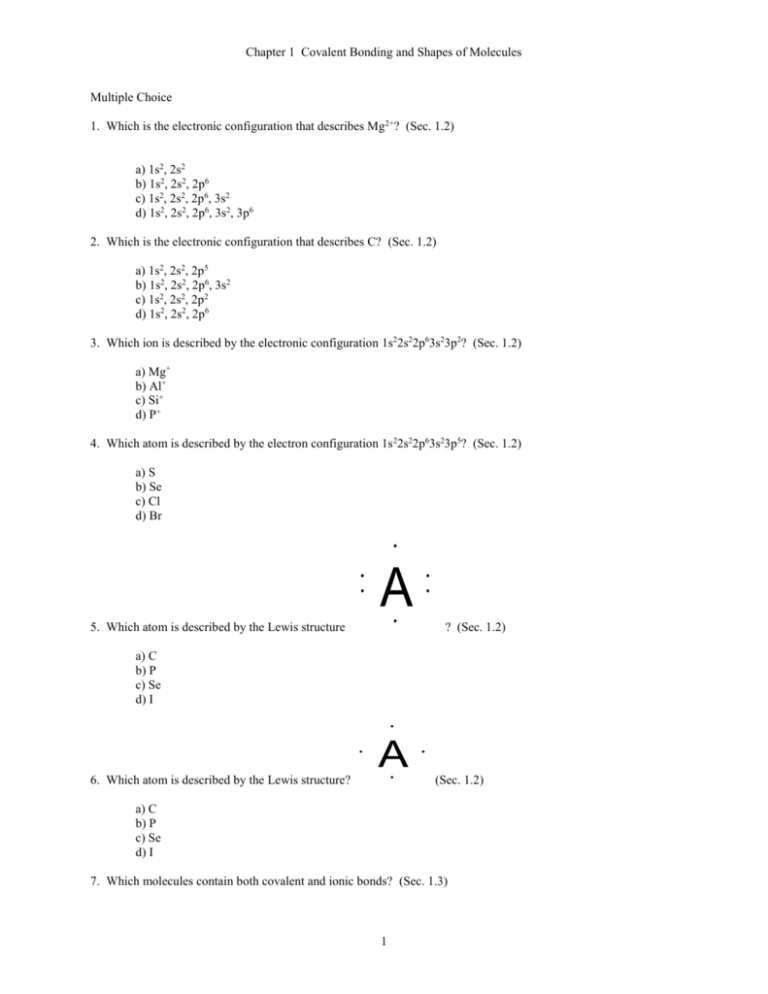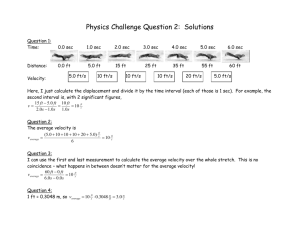LSU-ch01
advertisement

Chapter 1 Covalent Bonding and Shapes of Molecules Multiple Choice 1. Which is the electronic configuration that describes Mg2+? (Sec. 1.2) a) 1s2, 2s2 b) 1s2, 2s2, 2p6 c) 1s2, 2s2, 2p6, 3s2 d) 1s2, 2s2, 2p6, 3s2, 3p6 2. Which is the electronic configuration that describes C? (Sec. 1.2) a) 1s2, 2s2, 2p5 b) 1s2, 2s2, 2p6, 3s2 c) 1s2, 2s2, 2p2 d) 1s2, 2s2, 2p6 3. Which ion is described by the electronic configuration 1s22s22p63s23p2? (Sec. 1.2) a) Mg+ b) Al+ c) Si+ d) P+ 4. Which atom is described by the electron configuration 1s 22s22p63s23p5? (Sec. 1.2) a) S b) Se c) Cl d) Br A 5. Which atom is described by the Lewis structure ? (Sec. 1.2) a) C b) P c) Se d) I A 6. Which atom is described by the Lewis structure? (Sec. 1.2) a) C b) P c) Se d) I 7. Which molecules contain both covalent and ionic bonds? (Sec. 1.3) 1 Chapter 1 Covalent Bonding and Shapes of Molecules CH3OH I Na2CO3 II NH4Cl III NaCl IV a) I, II b) II, IV c) I, II, IV d) II, III 8. Arrange the bonds in increasing order of ionic character (least first). (Sec. 1.3) C-C I Na-O II C-N III O-H IV C-O V a) III, I, IV, II, V b) V, III, I, II, IV c) I, III, V, IV, II d) I, III, II, IV, V 9. Which Lewis structure is correct? (Sec. 1.3) H H H a) H C OH b) H C C H .. .. H c) H O O H .. .. d) H .. :O : .. O C O .. .. 10. Which Lewis structures are correct? (Sec. 1.3) H O O H H H H H H N N H H N O H C Cl H H III IV I II a) b) c) d) I, II II, IV III, IV I, III 11. Which molecules are polar? (Sec. 1.5) NH3 CO2 H2O I II III a) b) c) d) I, IV I, III II, III, IV III, IV, V 2 CH4 Br2 IV V H Chapter 1 Covalent Bonding and Shapes of Molecules 12. Which molecules are polar? (Sec. 1.5) O H2C CH2 I H C H II CH2Cl2 H3C CH3 CH3OH III IV V a) III, IV, V b) I, IV c) II, III, V d) I, III 13. Which functional groups have correct Lewis structures? (Sec. 1.3) O C O H C O hydroxyl I carbonyl II C O H carboxyl III a) I, II b) II, III c) I, II, III d) I, III 14. Which is the correct Lewis structure for acetic acid (CH 3CO2H)? (Sec. 1.3) H O H O H C C O H C C O H H H H a) H O H C O C H O H H O C C H H b) H c) 15. Using the VSEPR model, predict which atoms have bond angles of about 120°. (Sec. 1.4) 3 d) Chapter 1 Covalent Bonding and Shapes of Molecules O H3C C CH2 CH2 CH3OH H III II I NH4Cl IV a) II, IV b) I, IV c) II, III d) I, III 16. According to VSEPR model, what is your prediction for the arrangement of electron pairs for CH 3-? (Sec. 1.4) a) linear b) tetrahedral c) bent d) trigonal 17. Using the VSEPR model, predict which species have bond angles of about 109°. (Sec. 1.4) NH3 CO2 H2O H3O+ O3 I II III IV V a) I, III, IV b) II, III, V c) I, IV d) III, IV, V 18. What is the correct structure for the aldehyde which has the formula C4H8O? (Sec. 1.3) OH a) CH3 O CH CH CH2 b) CH3 C CH2 CH3 O c) CH3 CH2 CH2 CH d) H2C CH CH2 O CH3 19. Nitrogen has a negative formal charge in which of the following compounds? (Sec. 1.3) a) NaNH2 b) N2 c) NH4Cl d) HCN 20. What is the formal charge of oxygen in H3O+? (Sec. 1.3) a) –1 b) 0 c) +1 d) +2 4 Chapter 1 Covalent Bonding and Shapes of Molecules 21. What is the formal charge of indicated carbon in, NaC CH (Sec. 1.3) a) –2 b) –1 c) 0 d) +1 22. The carbon has the correct orbital hybridization in which structures? (Sec. 1.7) H2C O H2C CH2 sp I sp2 II CH4 HC N O C O sp IV sp V sp2 III a) II, IV, V b) II, III, IV c) I, II, III d) I, IV, V 23. What are the correct orbital hybridizations for carbon in the following species? (Sec. 1.7) A. CH3 I. sp B. CH4 II. sp2 C. CH 3 III. sp 3 a) A and I, B and III b) B and I, C and II c) A and III, C and II d) B and III, C and III 24. Which of the following are pairs of contributing resonance structures? (Sec. 1.6) I CH3 II III H2C O CH3 CH3 CH2 OH H2C O H2C O CH CH2 H2C IV N C O CH CH2 N C O 5 Chapter 1 Covalent Bonding and Shapes of Molecules a) II, IV b) I, II, III c) III, IV d) II, III, ,IV 25. Carbon has how many valence electrons? (Sec. 1.2) a) 2 b) 4 c) 6 d) 8 26. Oxygen has how many valence electrons? (Sec. 1.2) a) 4 b) 5 c) 6 d) 7 27. Nitrogen has how many valence electrons? (Sec. 1.2) a) 4 b) 5 c) 6 d) 7 28. Which statement about orbitals is false? (Sec. 1.2) a) Orbitals are regions of space where electrons are found. b) Orbitals may contain up to two electrons. c) Orbitals are filled in order of decreasing energy. d) Orbitals of equivalent energy are half filled before adding two electrons to any one of them. 29. Which statement about resonance structures is false? (Sec. 1.6) a) All contributing resonance structures must have the same number of valence electrons. b) All contributing structures must obey the rules of covalent bonding. c) The position of nuclei may change. d) Third period atoms may have up to 12 electrons around them. 30. Which functional groups are named correctly? (Sec. 1.8) O H3C C O O H alcohol I CH3 OH aldehyde II H3C H N CH3 C CH3 ketone III 6 CH3 amine IV H3C C OH carboxylic acid V Chapter 1 Covalent Bonding and Shapes of Molecules a) III, IV, V b) II, III, IV c) I, III, V d) I, III, IV 31. Which of the following compounds contains a tertiary (3°) alcohol? (Sec. 1.8) H3C HC OH H3C H3C C CH3 I OH H3C H3C II OH H3C C CH3 III a) I b) II c) III d) IV 7 CH2 H3C OH HC H3C CH CH3 IV Chapter 1 Covalent Bonding and Shapes of Molecules Fill in the Blanks 1. The spins of the electrons must be _______ in an orbital. (Sec. 1.2) 2. Outer shell electrons are called _________ electrons. (Sec. 1.2) 3. ______ is the number of valence electrons for S. (Sec. 1.2) 4. ______ is the number of valence electrons for Br. (Sec. 1.2) 5. The tendency of an element to react such that it achieves a noble gas configuration is called the ______ ______. (Sec. 1.2) 6. The most polar bond in the following molecule is __________. (Sec. 1.3) H OH H F C C C NH2 H H H 7. A __________ bond is characterized by the unequal sharing of electrons. (Sec. 1.3) 8. The following molecule contains the _________ and __________ functional groups. (Sec. 1.8) O OH 9. The following molecule contains the _________ and __________ functional groups. (Sec. 1.8) NH2 OH O 10. Functional groups undergo the same type of __________ in whatever compound they are found. (Sec. 1.8) 11. ______________ are the basis for compound nomenclature. (Sec. 1.8) True-False 1. Each shell can hold two electrons. (Sec. 1.2) 2. Orbitals make up the majority of the mass of an atom. (Sec. 1.2) 3. The group 7A elements react by losing an electron to achieve a noble gas configuration. (Sec. 1.3) 4. The group 2A elements react by losing two electrons to achieve a noble gas configuration. (Sec. 1.3) 8 Chapter 1 Covalent Bonding and Shapes of Molecules 5. Carbon reacts by gaining 4 electrons to achieve a noble gas configuration. (Sec. 1.3) 6. An atom that gains electrons is called an anion. (Sec. 1.3) 7. Ionic bonds are characterized by the unequal sharing of electrons. (Sec. 1.3) 8. The following molecule is an example of a secondary amine. (Sec. 1.8) H3C HC NH2 H3C 9. 10. CH3CH2CH2CH2CH2OH CH3ONa is a polar molecule. (Sec. 1.5) contains only polar covalent bonds. (Sec. 1.3) 9 Chapter 1 Covalent Bonding and Shapes of Molecules Answers Multiple Choice 1. b 2. c 3. d 4. c 5. c 6. a 7. d 8. c 9. d 10. c 11. b 12. c 13. d 14. d 15. d 16. b 17. a 18. c 19. a 20. c 21. b 22. a 23. c 24. c 25. b 26. c 27. b 28. c 29. c 30. a 31. b Fill in the Blank 1. paired 2. valence 3. 6 4. 7 5. octet rule 6. C-F 7. polar covalent 8. ketone, alcohol 9. 1° amine, carboxylic acid 10. reactions 11. Functional groups True-False 1. F 2. F 3. F 4. T 5. F 6. T 10 Chapter 1 Covalent Bonding and Shapes of Molecules 7. F 8. F 9. T 10. F 11








